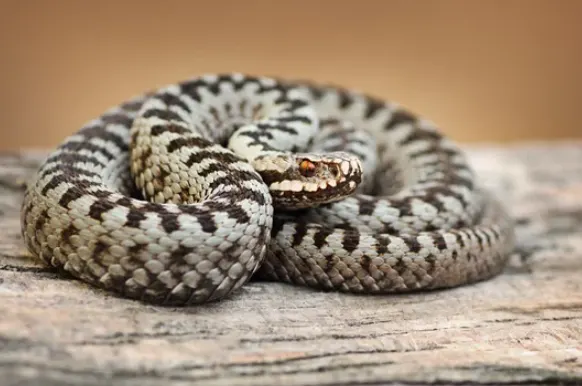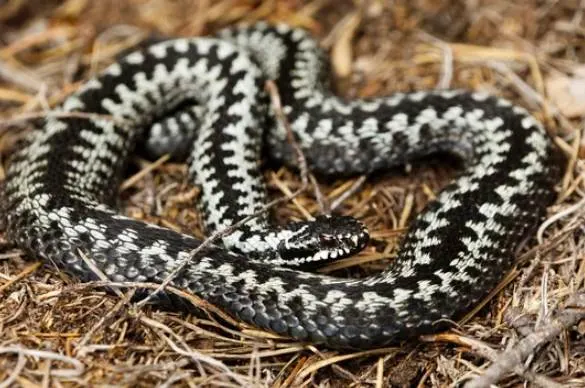The Common European Adder, also known as Vipera berus, is one of Europe’s most widespread and fascinating snake species. Renowned for its distinctive zigzag pattern and remarkable ability to thrive in some of the coldest regions on Earth, this viper has intrigued scientists and snake enthusiasts alike. In this blog post, we’ll explore everything you need to know about the Common European Adder, from its habitat and behavior to its conservation status and interactions with humans.

Table of Contents
Habitat and Distribution: A Snake Above the Arctic Circle
The Common European Adder has a wide distribution, covering most of Europe and parts of Asia. It is unique in that it is the only snake species found above the Arctic Circle. This adaptability to cold climates sets it apart from other snakes, which typically prefer warmer environments. The adder’s range extends from the southern parts of Greece to the northern reaches of Scandinavia, and from Great Britain to northern China.
In these regions, the adder inhabits a variety of environments, including forest edges, grasslands, and riverbanks. It’s a terrestrial species, spending most of its time on the ground. However, it’s not uncommon to find adders basking on small bushes or hillsides, especially in the cooler months when they seek out the warmth of the sun.
Physical Characteristics: The Iconic Zigzag Pattern
The Common European Adder is easily recognized by its distinct physical features. It typically measures between 24 to 36 inches in length, with females being larger than males. This species is sexually dimorphic, meaning males and females have different coloration. Males are usually silvery-gray, while females tend to be brown. Both sexes have a characteristic dark zigzag pattern running down their backs and a V-shaped or X-shaped marking on their heads.
In some cases, particularly in colder regions, adders can be melanistic, appearing completely black. These melanistic individuals are often mistaken for a different species but are simply a color variation of the Common European Adder. Despite their small size, adders have a robust and stocky build, which helps them retain body heat in colder climates.
Behavior and Diet: A Timid Predator
Common European Adders are primarily solitary and exhibit timid behavior. They are not aggressive and will usually flee when confronted by humans. However, if threatened or stepped on, they may bite in self-defense. It’s important to note that adder bites, while venomous, are rarely fatal to humans. Most bites result in mild symptoms such as pain, swelling, and nausea, with serious complications being extremely rare.
The adder’s diet consists mainly of small mammals, such as mice and shrews, as well as lizards, amphibians, and occasionally bird eggs. They are opportunistic feeders, employing both ambush and active hunting strategies. In cooler regions, adders are diurnal, meaning they are active during the day. In warmer climates, however, they may also hunt at night to avoid the heat.
Reproduction and Lifespan: Hibernation and Birth
One of the most interesting aspects of the Common European Adder’s life cycle is its reproductive strategy, which is closely tied to its hibernation habits. Adders hibernate for up to nine months of the year in the colder parts of their range, emerging only during the warmer months to feed and reproduce. In some cases, females may give birth to live young while still in hibernation.
Unlike many snakes that lay eggs, adders are ovoviviparous, meaning they give birth to live young. A typical litter consists of three to twenty young, which are born fully developed and resemble miniature versions of the adults. After birth, the young may stay with the mother for a few days before venturing off on their own.
Conservation Status: A Species in Decline
The Common European Adder is currently classified as “Least Concern” by the IUCN Red List, but its population is declining in many areas, particularly in the United Kingdom. Habitat loss, human encroachment, and the introduction of non-native species are significant threats to the adder’s survival. In the UK, the adder is a protected species, and conservation efforts are underway to preserve its remaining populations.
Researchers are particularly concerned about the genetic diversity of adder populations in fragmented habitats. Studies are being conducted to assess the viability of these populations and to develop strategies for their conservation. In some parts of Europe and Asia, the adder remains common, but without continued conservation efforts, its future could be at risk.
The Adder in Culture and Mythology
The Common European Adder has a long history in European folklore and mythology. In many cultures, snakes are symbols of both danger and healing, and the adder is no exception. In medieval Europe, the adder was often associated with treachery and deceit, likely due to its venomous nature. However, it was also believed to have medicinal properties, and its venom was sometimes used in traditional remedies.
In more recent times, the adder has become a symbol of wilderness and natural beauty, particularly in the UK, where efforts to conserve its dwindling populations are closely tied to broader environmental conservation initiatives. The adder’s presence in folklore and popular culture reflects the complex relationship humans have with this often misunderstood creature.
Human Interaction: Safety and Awareness
While the Common European Adder is venomous, it poses little threat to humans if left undisturbed. Most bites occur when people accidentally step on or attempt to handle the snake. To avoid encounters, it’s advisable to wear sturdy boots when walking in areas known to be inhabited by adders, particularly in the spring and summer when they are most active.
Education and awareness are crucial in reducing negative interactions between humans and adders. Many people fear snakes due to a lack of understanding, but learning about the adder’s behavior and ecological role can help foster a greater appreciation for this unique species. Adders play an important role in controlling rodent populations, and their presence is an indicator of a healthy ecosystem.

The Future of the Common European Adder
The Common European Adder is a remarkable species, not just for its ability to survive in harsh climates, but also for its role in the ecosystems it inhabits. As human activity continues to impact natural habitats, the adder’s future remains uncertain. However, with continued conservation efforts and greater public awareness, there is hope that this iconic snake will continue to thrive in the wild for generations to come.
By understanding and respecting the Common European Adder, we can ensure that this unique viper remains a part of Europe’s natural heritage. Whether you encounter one in the wild or simply learn about them from afar, the adder’s story is a reminder of the resilience and adaptability of nature in the face of change.
- Enchi Ball Python: A Unique and Stunning Morph of Python regius - March 27, 2025
- Emerald Tree Monitor: The Enigmatic Green Guardian of the Rainforest - March 26, 2025
- The Egyptian Cobra (Naja haje): A Fascinating Serpent - March 25, 2025
